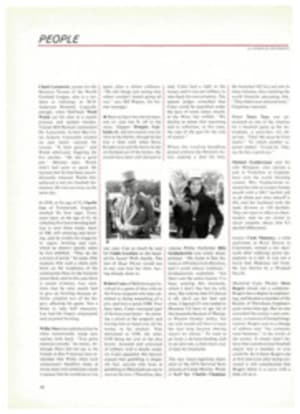
SCORECARD
COUNTING DOWN
After two years of deliberations the Department of Health, Education and Welfare has proposed its regulations to implement Title IX (SCORECARD, May 20), a subsection of education amendments passed by Congress in 1972 that prohibits sex discrimination in educational institutions receiving federal funds, i.e., a majority of the schools in the country.
Title IX has precipitated considerable controversy, particularly as it pertains to college athletics. "Impending doom is around the corner if these regulations are implemented," said Walter Byers of the National Collegiate Athletic Association with resounding redundancy after scanning a rough draft last February. Some women educators wanted Title IX to mirror men's athletic programs with equal scholarships and funding for women, some feared that "separate but equal" programs would be proposed (they were not), but all agreed they would die on the battlements fighting an amendment introduced in the Senate a few weeks ago by John Tower of Texas that would have exempted revenue-producing sports (read football and basketball) from Title IX. The amendment was killed in a House-Senate conference.
Considering the depth of feeling, it is not surprising that HEW's regulations are vague and hard to interpret, but boiled down they appear to say that without question schools will have to upgrade their women's athletic programs, that the emphasis will be on equal opportunity, not equal expenditure, and that since it is highly unlikely that men's athletic programs will be greatly reduced, more monies must be found for women's sports.
The regulations are only proposals; they are not final. Secretary Caspar Weinberger and his staff will continue to listen to public comment until Oct. 15, after which date they will submit the ultimate, absolute final draft to President Nixon for approval. Weinberger guesses the regulations will go into effect on Jan. 1, 1975. Then, probably, it will be business as usual for football, but cancel those fund-raising bake sales for women's teams. They will be riding to championships on prepaid tickets, too.
LINKS LINK
Chief Superintendent Dick Saxby, detective of New Scotland Yard, struck up a fairways connection with Bruce Brown, sociable captain of their Middlesex golf club. The friendship spread to meetings off the course. Saxby invited Brown to a policemen's dinner and dance. The Browns and the Saxbys spent a jolly weekend in Germany. When Saxby was promoted, Brown was at the party. It will be Brown's last party for some time, though. Policemen, Saxby not among them, alas, unmasked Brown as the leader of a gang of bank robbers. Twenty-one years. Bad show, Saxby.
GRIM TOLL
For those frightened of air travel, some statistics from the National Transportation Safety Board for 1973: while 227 people lost their lives in commercial aviation accidents, more than 1,100 were killed on bicycles, 1,340 in general aviation, 1,754 boating, fishing and cruising and 3,300 on motorcycles. A good swatch of the bicycle deaths were caused by careless automobile drivers.
EASY DOESN'T DO IT
If Rex Golobic had his way, he probably would hire the maintenance men from Winged Foot and set them to work conditioning the bowling lanes around the country with the same meticulous care they devoted to the U.S. Open course. Golobic is president of the Bowling Proprietors' Association of America and he is frightened that his game is becoming monotonous for the spectator because it is too easy for the bowler.
"It is not the ease with which the pros can string strikes together that makes a good TV show," he says, "but their manner of coping with difficulties. Good spare shooting has virtually ceased to be a factor, because the pros are seldom called upon to make anything other than one-pin spares."
Golobic would not do anything drastic, like festooning lanes with miniature sand traps, but he does think that extending the dressing applied to the fore part of the lanes to the last 15 feet before the headpin—it is more difficult to execute and control a hook on dressing—might help restore the days when averages of 190 to 200 were considered excellent. Some tournament handicapping today is based on averages of around 220. The American Bowling Congress, which had just been congratulating itself on its highest-scoring meet ever at Indianapolis, was maintaining a low profile. "I don't expect any official response," said an official.
FOR THE BIRDS
Buffalo Bill, in e. e. cummings' brilliant lament, rode a watersmooth-silver stallion and broke onetwothreefourfive pigeonsjustlike that. In Germany, claim indignant officials of the West German Animal Protection League, the slaughter of real pigeons is not anywhere near as neat but it is a lot broader—seveneightninehundredthousand pigeonsjustlike that. Worse, and may Cody spin in his grave, the weapon is sex.
Fanciers have long played upon the monogamous instincts of the racing birds to speed them home. They remove the male just before he mates with the female and pack him off several hundred miles to a starting point from which, if all goes well, the faithful fellow will dash home to the one and only in record time. Unfair enough, but the method cannot hold a feather to what goes on back in the Ruhr, where there are three million pigeons, many crazed with jealousy.
The Germans, it seems, put a married couple in one cage and in another, separated by an opaque board, a bachelor bird. Periodically, the board is lifted long enough to give the two males ideas bin not long enough for them to fight. When the married male leaves for his race, says the WGAPL, he does so with a neurotic fear that he will return home to find divorce papers filed. He loses his head in his mad desire to get back to the loft and takes unnatural risks, often perishing after battling rain and hail or tearing into power lines. The WGAPL claims that by this means almost a third of the region's racing pigeons are lost each year.
"Sentimental twaddle," says Alfred Kozlowski, president of a racing association. "We are rendering the pigeons a real service by enabling them to achieve higher performances...After all, achievement is the whole purpose of life."
Which puts us in mind of the ending of cummings' poem: "what i want to know is how do you like your blueyed boy Mister Death"?
DOUBLE JEOPARDY
It is not often that a tennis player can lose two singles matches against different opponents on the same day 1,200 miles apart. But that is what Stan Smith did recently, battling himself, so to speak, in the Nielsen ratings and emerging a big loser all round. On a TV program called the CBS Tennis Classic, Englishman Mark Cox blasted Smith in straight sets on an overcast day in Austin, Texas. A flip of a channel away, on ABC-TV, Rod Laver was beating up on poor Smith in the very same time slot in the World Invitational Tennis Classic at sweltering Hilton Head Island, S.C. Anybody for a case of classic overexposure?
LES MOTS JUSTES
Back when sportswriting was sports-writing, this, in part, is how a Quincy, Ill. paper told it the way it was after the local nine went down to what—in the absence of any score—must have been calamitous defeat, before the turn of the century:
"The glass-armed toy soldiers of this town were fed to the pigs yesterday by the cadaverous Indian grave-robbers from Omaha. The flabby, one-lunged Reubens...had their shins toasted by the basilisk-eyed cattle-drivers from the West.
"They stood around with gaping eyeballs like a hen on a hotnail and suffered the grizzly yaps of Omaha to run bases until their necks were long with thirst. Hickey had more errors than Coin's Financial School....
"The Quincys were full of straw and scrapiron. They couldn't hit a brick wagon with a pickax, and ran bases like pallbearers at a funeral. If three-base hits were growing at the back of every man's neck they couldn't reach 'em with a featherduster....
"The game was whiskered and frostbitten. The Omahogs were bad enough, but the Quincy Brown Sox had their fins sewn up until they couldn't hold a crazy quilt unless it was tied around their necks."
The writer, for obvious reasons, was anonymous.
CLAUSED CIRCUIT
It is a lamentable fact of these parlous times that even the pattest of arguments turn to mush. A cherished view of National Football League owners and the basis of the lawsuit filed by the Cincinnati Bengals against Linebacker Bill Bergey is that no man who has signed a contract to play with another club in future years can possibly perform during the interim with the élan and dedication expected of him by his present employer. Sounds sensible, but going back a few years, one famous case would seem to prove the opposite.
It happened in 1949 and involved George Ratterman, the old Notre Dame quarterback, who announced that he was playing out the option in his contract with the Buffalo Bills of the All-America Football Conference. What Ratterman neglected to tell anybody was that he already had signed to spend 1950 in the company of the New York Yanks of the NFL. Nobody ever suspected. Although he missed training camp and the season opener, Ratterman had his best year of the three he spent with Buffalo, leading the Bills into the playoffs, where they were defeated by Cleveland 31-21. His completion percentage of 57.9% was the highest in the league, and he topped that off by starting ahead of Y. A. Tittle and Frankie Albert in the postseason All-Star game against Cleveland, won by the Stars 12-7. Ratterman played six seasons in the NFL but never had a year to equal his last with the Bills.
HIGH RISE, LOW PRICE
With costs of the Louisiana Superdome soaring over the $160 million mark and the end not yet in sight, it is nice to report this story of low finance in Payette, Idaho. A community of 4,700 just across the Snake River from Ontario, Ore., Payette is this very week moving into a dome of its own. The building, 150 feet in diameter and 86 feet tall, has been turned into a new gymnasium for the high school. There is room enough for three basketball courts, one full-sized, the others not very much smaller, and 2,500 spectators. Badminton anybody? Fight games can be played simultaneously. On a large balcony running around the courts there is space for, among many activities, wrestling, gymnastics and band practice. The cost: $300,000.
If that seems unbelievable, it is not. The project took shape 14 years ago in the mind of John Campbell, then a young teacher, who shepherded his physics classes to Dooley Mountain in Oregon to observe work being done on an Air Force radar dome. Campbell eventually became superintendent of the Payette school system, and last year, when the Dooley dome was declared surplus, he struck. After much ado the town got the dome for the cost of carting it away. It gives the little high school one of the finest gyms in the state and is the biggest hit in town since Harmon Killebrew was clouting thunderous flies into the surrounding desert.
ILLUSTRATION
THEY SAID IT
•Frank D. Tatum Jr., USGA, on the difficult pin placements in the U.S. Open: "We had no intention of confounding the best players in the world. We just wanted to identify who they were."
•Randy Rasmussen, New York Jets guard and off-season stockbroker: "Every time I look at the market reports I love pro football more and more."
•Leigh Buck, member of the U.S. women's lacrosse team, on why she has no record of her goals: "Girls aren't hot dogs like some of the men. We play a fundamental game and don't emphasize statistics."

